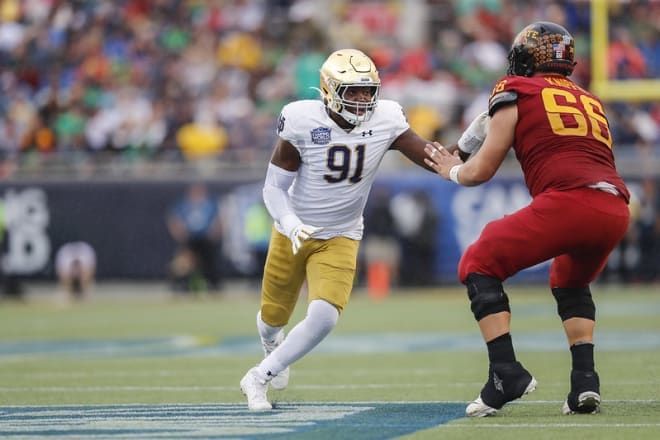Engel’s Friday Five: Notre Dame’s Development … And Its Upcoming Test
You were curious enough to hit the link.
I’ll trick myself into thinking it’s because you might care what I have to say, for some reason.
After nearly 11 months covering Notre Dame, I like to now believe the words that appear under this byline on this site each day are not complete claptrap. On that, speak now or forever hold your peace.
I write a lot about what happens and what is said. Not as much about what I think of it. I have no shortage of things to say on the topics, though. Think of this new column as a supplement. Or your weekly hate read.

Most Fridays, I will present five musings on anything pertaining to Notre Dame athletics, whether it’s news directly involving the program, national college sports happenings or something else around sports that makes me ask, “What does this mean for Notre Dame?” It’ll be mainly football, but always something on basketball. I hope you leave having learned something.
Away we go.
‘A Developmental Process’
Earlier this month, we heard Notre Dame’s coaching staff expound upon its recruiting process, operations, emphases and much more. Some of it was rehashed tales and self-congratulating. Other parts were truly enlightening. I keep thinking back to defensive line coach Mike Elston’s comments on player development for a couple reasons.
He has proven himself there as much as anyone else on staff. And that day was the four-year anniversary of signing the 2017 class.
The ’17 group yielded four three-star recruits who became multi-year starters, another in receiver Avery Davis primed to be a two-season starter and a potential starter as a fifth-year senior in guard Dillan Gibbons. That class was assembled amid a coaching staff overhaul, had six players join in the final week before signing day and still turned into some of Notre Dame’s best work.
“Whether it's a guy that’s got a high rating or a low rating,” Elston said, “we’re looking for a young man that has a high ceiling, and we want his best days of football to be ahead.”
Signing day 2017 flip Jeremiah Owusu-Koramoah certainly fit that description. So did the haul of four defensive ends from the 2016 class, which had a five-star signee in Daelin Hayes, two lower-ranked four-stars in Julian Okwara and Khalid Kareem, and low three-star ex-MAC commit in Ade Ogundeji. Hayes and Kareem were the only Rivals250 players.
Hayes was a camp all-star, his ranking based all on upside and little on production. He played seven games in his final three years of high school due to injuries. Ogundeji was once headed to Western Michigan, a toolsy player too skinny to see the field for a Power Five team right away. Different ratings and backstories, but both needed a lot of molding.
Both are now projected draft picks after taking over for Okwara and Kareem, who were third- and fifth-round 2020 selections, respectively. There was little drop-off. Hayes is a third-rounder in TheDraftScout.com analyst Matt Miller’s seven-round mock, and Ogundeji a fourth-round selection.
“You’re going to put them through a developmental process within your program, and then you’re going to find out what kind of class you signed,” Elston said. “You’re not going to know what that class looks like until they go through your process.”
The 2016 defensive end quartet and 2017 class grade out much higher than their ranking.
Rivals had 17 weak-side defensive ends ahead of Okwara. Three were drafted (a fourth, Ohio State’s Jonathon Cooper, is likely to join them). Excluding Kareem, there were 34 nationally-ranked strong-side ends in 2016 (Ogundeji was not one). Four were drafted, and they were all in the top five at the position. Hayes is one of two 2016 five-star outside linebackers who is in the NFL or a projected pick.
That’s development in action. And there’s how Notre Dame has outplayed the recruiting rankings forecasts.
Far-Out Scheduling
Adding Florida to the future schedule makes sense and fits the trend of going for it. From 2021-32, Notre Dame has at least two of Ohio State, Clemson, Texas A&M, Miami, Florida State, Alabama, USC (presumably) and Florida on tap every year. That’s a lot of potential schedule power.
Planned out way ahead of time, too.
I was skeptical of the need to set games decades in advance before the pandemic threw scheduling in the blender. Adding them on the fly this season — literally days before — convinced me there’s no logical reason to keep doing this 10 to 15 years out. Coastal Carolina and BYU adding a game with three days to prep is extreme, too, but I’ve yet to hear a convincing argument why it can’t be done within, say, five years.
It doesn’t make much difference to give fans five years’ heads up instead of 10. Concerts at the venues aren’t booked that far out, or even booked during football season. I know every major program wants to make sure they lock in seven home games for season tickets and game-day revenue, but those are never much of a problem for basketball seasons.
In the end, it’s a small potatoes gripe. If nothing else, we get to keep joking on Twitter about how we’ll be watching these games from retirement homes and tailgating out of flying cars.
Ian Book
A truncated version of my column in the latest Blue & Gold Illustrated magazine …
Whatever you think of quarterback Ian Book, there’s one undeniable reality.
Losing him deals Notre Dame’s 2021 offense a setback. A meaningful one that leads me to this prediction: the Irish faithful will have more moments when they wish he was still around than moments when they’re glad he’s gone, because of what he was and who’s in line to take over.
Let’s start with the former. What was Ian Book? You know the accolades by this point. All-time wins leader, three-year starter, two-time captain and so on.
The NFL also sees more value in him than most think.
“His mobility is the key to his evaluation, and despite his inconsistent downfield reads and touch, his confidence and winning résumé go a long way with evaluators,” wrote Dane Brugler, The Athletic’s NFL Draft analyst, in a January Senior Bowl preview. “Book is a mid-to-late rounder for me, but some around the league, they see a quarterback who will go in the top four rounds.”
We know the tallest hurdle that comes with finding Book’s replacement is the likelihood Notre Dame needs, among other things, an improvement on the winningest quarterback in school history to fetch a national title.
Thing is, how much better will his successors be this season than what he did provide? I’m not putting crazy expectations on freshman Tyler Buchner to deliver Book’s steadiness. Same with Drew Pyne or Brendon Clark, who have a combined seven pass attempts. Grad transfer Jack Coan is a stabilizer, but is he going to be better than Book? Again, a lot to ask.
Better than Ian Book exists, but it’s a tier occupied by fewer quarterbacks than Notre Dame fans think. This season will provide plenty of hindsight realizations that confirm it.
The SP+ Rankings
I was surprised to see the preseason SP+ rankings spit Notre Dame out at No. 25. That might make you might hate the method, but you should at least understand how the method created the result.
Preseason SP+ is roughly two-thirds based on returning production and last year’s ratings. On those two: Notre Dame finished 16th in SP+ after taking consecutive losses the formula did not like. And the Irish are 123rd in returning production (123rd on offense, 108th on defense).
I get it. Overall, I think it’s a sound ranking rooted in good principles. You can dive deeper into every team’s spot, but here’s the context I’m looking at it through:
Those losses were two games out of 12 against an Alabama team nobody touched and Trevor Lawrence-led Clemson, which lost twice in three years to national championship participants. I don’t see the 2021 Notre Dame team beating equivalent outfits. There aren’t any on the schedule, though. Neither made me think a retooled but still good 2021 outfit won’t be competitive with (or straight up beat) Wisconsin or North Carolina.
The production is a real hurdle and more so than prior years. Heading into 2020, the Irish were 83rd in returning production. In 2019, they were 97th. This is a tougher than usual task.
At the same time, 83rd and 97th is still a lot of production lost. And it hasn’t been a roadblock consistently reaching 10 wins. With Coan, the outcome range at quarterback is easier to peg. That’s a good thing. The options at most of these empty spots aren’t patently inferior to the guys they’re replacing. They just have to go and actually play as their recruiting ranking or small sample size suggests they can. (Or in cases like receiver Kevin Austin Jr., just get healthy).
That’s all about development. I’ve already written in here about Notre Dame’s capabilities in that area. I’m not sure the ceiling for the 2021 team is as high as 2020, but the floor of 25th in a predictive metric feels a bit low.
Getting Defensive
Notre Dame basketball wins shootouts, not slugfests.
An offense that ranks 13th in KenPom’s adjusted efficiency, 15th in three-point percentage, 12th in turnover rate and 51st in three-point volume is built for them. But so is a decidedly average defense.
Notre Dame is 152nd nationally in adjusted defensive efficiency and 12th out of 15 ACC teams in league games. The Irish have played 894 possessions of man defense and rank in the ninth percentile (0.93 points per possession). They have used zone on 307 possessions and are in the 27th percentile (0.99 PPP). The defensive strategy changes based on game flow and opponent. Neither has been consistently effective.
Tuesday’s 93-89 win over Duke, though, was intriguing.
Notre Dame played zone on 19 half-court possessions and only allowed seven scores. In man, it gave up scores on 25 of 51 possessions. The Irish played most of the final 10 minutes in zone.
That’s worth noting with Miami up next on Sunday. In a road victory over the Hurricanes Jan. 24, Notre Dame played 30 more possessions of zone than man and gave up a score just 26.5 percent of the time in zone. The end result was a 73-59 victory in which Miami averaged 0.87 PPP. The zone flustered a dribble-drive heavy Miami offense and made a low-volume, low-accuracy three-point shooting team take 35.4 percent of its shots from deep.

----
• Learn more about our print and digital publication, Blue & Gold Illustrated.
• Watch our videos and subscribe to our YouTube channel.
• Sign up for Blue & Gold's news alerts and daily newsletter.
• Subscribe to our podcast on Apple Podcasts.
• Follow us on Twitter: @BGINews, @BGI_LouSomogyi, @Rivals_Singer, @PatrickEngel_, @MasonPlummer_ and @AndrewMentock.
• Like us on Facebook.


